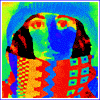 Segmentation map
of chromosomes
Segmentation map
of chromosomes
^Laboratory for Cell Analysis, University of California San Francisco, USA.
*Faculty of Applied Physics, Delft University of Technology, The Netherlands.
The traditional analysis and assembly of metaphase chromosomes into a karyogram
is a slow and tedious process requiring intermediate photographic steps and
manual manipulation of the chromosome images. Much of this task is highly
repetitive and readily lends itself to partial automation. Semi-automated
karyotyping systems now are being used increasingly in both clinical and research
cytogenetic laboratories. Digital image processing techniques are used to
capture, manipulate, and make an initial classification of chromosome images.
 Segmentation map
of chromosomes
Segmentation map
of chromosomes
The Athena system uses commercially available components based on a Macintosh II personal computer. Digital image processing procedures automatically isolate chromosome images from the metaphase and arrange them into a karyogram, using information about relative chromosome length, centromeric index, and banding pattern. The operator uses the intuitive graphics interface of the Macintosh computer to monitor each phase of the analysis, to resolve any problems in isolating chromosome images, and to rearrange the individual chromosome images as necessary while assembling the final karyogram. Athena is designed as a semi-automated karyotyping system that is easy to learn and has sufficient power and versatility for routine use in the analysis of human metaphase chromosomes.
 e-mail:
young@ph.tn.tudelft.nl
e-mail:
young@ph.tn.tudelft.nl
Last update: 8 February 1995